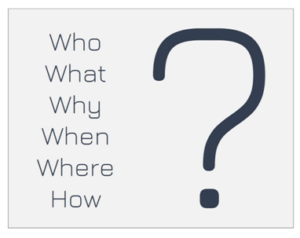Six words that should form the basis of every marketing strategy
The marketing text books are full of fancy models for market analysis, brand building and strategy. They are taught at universities across the country and churned out by consultants as a way of lending credibility to their proposals. I have studied many of these theories myself and used a few during my career spanning over 25 years, but there is one practice that stands out above all the rest as being simple, practical and effective. I am talking about six words that ask six questions; the answers are the key to a successful marketing strategy for every business, regardless of size or sector.

There it is in a nutshell – who, what, why, when, where, how? It’s simple to remember and it works, but some explanation may be required to illustrate what it means and to give an understanding of how to use it, so let’s break it down:
WHO?
Fundamentally, this is about identifying your target market. In it’s simplest form it asks the question ‘who are your customers?’ but it’s often not quite as simple as identifying just one target group. Particularly in the B2B world, the person making the purchase may not be the sole decision maker. So we should be asking a series of ‘who’ questions as follows:
- Who is the paying customer?
- Who is the decision maker?
- Who influences that decision?
- Who holds the purse strings?
- Who is the end user?
WHAT?
Having identified who the target groups are, the next question is ‘what do they want?’. The answer to this may well be different for each group. For example, the end user may be more interested in the functionality, aesthetics and performance, whereas the person holding the purse strings may be more interested in the cost and durability.
In some markets this can become more complex, as customers may be segmented according to what they want. As an example let’s look at the car industry, where people buy cars for many different purposes and are motivated by different things: brand and prestige, reliability, size and space, fuel economy or range, purchase cost, emissions and environmental impact, comfort, tax liability for company cars, size and load space, off road ability… and so the list goes on. In this case, the answer to what they want is not simply ‘a car’, but is qualified by the particular benefits that are important to each customer.
WHY AND WHEN?
Why and when customers are making a purchase are often closely linked, so it makes sense to consider them at the same time. People usually enter a market because they have a specific need. Understanding what is motivating your customers enables you to tailor your products and services to meet their needs and it should be front-of-mind when communicating with potential customers. Furthermore timing can be all-important, so recognising the triggers to purchase is also key. Once again, this may vary from one target group to the next, and may be a useful way to further segment your market.
There could be many triggers to purchase: Demand could be seasonal, it may follow another event like moving house or receiving an inheritance, it could be a distress purchase because something has broken, or be the result of poor performance from an existing supplier. If you know what drives the demand for your products and services, you can address this in the content on your website and marketing messaging… and if you ask a potential customer why they have contacted you, it can help you ensure that you address their specific needs in your pitch.
WHERE AND HOW?
Let’s start with where and how your potential customers do their research and selection. Increasingly this is online, but it’s worth considering other means of communication, including all advertising media, events, showrooms, retail outlets, word of mouth, and so on.
Related to this is where and how they make their purchase. It can be helpful to undertake a strategic review of all the possible routes to market. For example, it is increasingly common for B2B businesses to start selling directly to end users via their website. As they are effectively competing with their own customers, it needs to be managed carefully, but it can still be an effective way to generate incremental sales. Some manage this sensitively by taking an order online that is then passed to one of their trade customers for fulfilment.
WHAT DOES IT ALL MEAN?
The answers to these questions will not create a marketing strategy, but they will provide a solid foundation of knowledge upon which to build that strategy. Once you understand your customers, you can take the necessary steps to ensure that:
- Your products and services meet their needs
- Your business is visible at the right time and place to be considered as a possible supplier
- The way you communicate with your prospects is compelling and engaging
- Your products and services are accessible to as many potential customers as possible
HERE TO HELP
Every business is different, and these questions need to be answered within the context of the business and the market or markets in which they operate. The strategic team at 49Red have a wealth of experience in applying this model to businesses both large and small. If you would like to speak to one of our experts, we’d love to hear from you.


